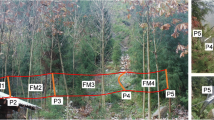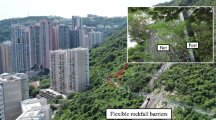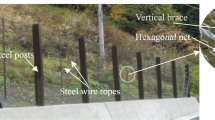Abstract
Flexible rockfall barriers are a common form of protection against falling blocks of rock and rock fragments (rockfall). These barriers consist of a system of cables, posts, and a mesh, and their capacity is typically quantified in terms of the threshold of impact (kinetic) energy at which the barrier fails. This threshold, referred to here as the “critical energy,” is often regarded as a constant. However, several studies have pointed out that there is no single representative value of critical energy for a given barrier. Instead, the critical energy decreases as the block size decreases, a phenomenon referred to as the “bullet effect.” In this paper, we present a simple analytical model for determining the critical energy of a flexible barrier. The model considers a block that impacts normally and centrally on the wire mesh, and rather than incorporate the structural details of the cables and posts explicitly, the supporting elements are replaced by springs of representative stiffness. The analysis reveals the dependence of the critical energy on the block size, as well as other relevant variables, and it provides physical insight into the impact problem. For example, it is shown that bending of the wire mesh during impact reduces the axial force that can be sustained within the wires, thus reducing the energy that can be absorbed. The formulas derived in the paper are straightforward to use, and the analytical predictions compare favorably with data available in the literature.
Similar content being viewed by others
References
Anderheggen E, Volkwein A, Grassl H (2002) Numerical simulation of highly flexible rockfall protection systems. In: Proceedings of the fifth world congress on computational mechanics (WCCM V), Vienna, Austria
Arndt B, Ortiz T, Turner AK (2009) Colorado’s full-scale field testing of rockfall attenuator systems. Transp Res Circular, E-C141. Transportation Research Board, Washington
Bertolo P, Oggeri C, Peila D (2009) Full-scale testing of draped nets for rock fall protection. Can Geotech J 46:306–317. doi:10.1139/t08-126
Buzzi O, Giacomini A, Spadari M, Fityus S (2011) Numerical modeling of a rock fall mesh perforation upon impact. In: Proceedings of the 13th international conference of the international association for computer methods and advances in geomechanics, Sydney, Australia
Buzzi O, Spadari M, Giacomini A, Fityus S, Sloan SW (2012) Experimental testing of rockfall barriers designed for the low range of impact energy. Rock Mech Rock Eng. doi:10.1007/s00603-012-0295-1
Cantarelli G, Giani GP, Gottardi G, Govoni L (2008) Modelling rockfall protection fences In: Proceedings of the first world landslide forum, Tokyo, Japan
Cazzani A, Mongiovì L, Frenez T (2002) Dynamic finite element analysis of interceptive devices for falling rocks. Int J Rock Mech Min Sci 39:303–321
De Col R, Cocco S (1996) Motivazioni tecniche ed economiche per la standardizzazione di prove sulle opere paramassi nella Provincia Autonoma di Trento. In: Giornata di studio su ‘‘La protezione contro la caduta di massi dai versanti rocciosi’’. GEAM, Torino, pp 65–72
EOTA (2008) Guideline for European technical approval of falling rock protection kits (ETAG 027), Feb 2008, Brussels. http://www.eota.be/en-gb/content/endorsed-etag-s/9/
Giani GP (1992) Rock slope stability analysis. Balkema, Rotterdam
Grassl H, Volkwein A, Anderheggen E, Ammann WJ (2002) Steel-net rockfall protection—experimental and numerical simulation. In: Proceedings of the seventh international conference on structures under shock and impact, Montreal, Canada
Hearn G, Barrett RK, McMullen ML (1992) CDOT flexpost rockfall fence development, testing, and analysis. Transp Res Rec 1343:23–29
Hearn G, Barrett RK, Henson HH (1995) Testing and modeling of two rockfall barriers. Transp Res Rec 1504:1–11
Jirásek M, Bazant ZP (2002) Inelastic analysis of structures. Wiley, Hoboken
Peila D, Oggeri C (2003) The use of rockfall protection systems in surface mining activity. Int J Surf Min Reclam Environ 17:51–64. doi:10.1076/ijsm.17.1.51.8625
Peila D, Ronco C (2009) Design of rockfall net fences and the new ETAG 027 European guideline. Nat Hazards Earth Syst Sci 9:1291–1298
Peila D, Pelizza S, Sassudelli F (1998) Evaluation of behaviour of rockfall restraining nets by full scale tests. Rock Mech Rock Eng 31:1–24. doi:10.1007/s006030050006
Smith DD, Duffy JD (1990) Field tests and evaluation of rockfall restraining nets, final report. California Department of Transportation, Sacramento
Spadari M, Giacomini A, Buzzi O, Hambleton JP (2012) Prediction of the bullet effect for rockfall barriers: a scaling approach. Rock Mech Rock Eng 45:131–144. doi:10.1007/s00603-011-0203-0
Volkwein A (2005) Numerical simulation of flexible rockfall protection systems. In: Proceedings of the 2005 ASCE international conference on computing in civil engineering. Cancun, Mexico
Volkwein A, Melis L, Haller B, Pfeifer R (2005) Protection from landslides and high speed rockfall events: reconstruction of Chapman’s peak drive. In: Proceedings of the 2005 IABSE symposium. Lisbon, Portugal
Acknowledgments
Financial support provided by the ARC Centre of Excellence for Geotechnical Science and Engineering (grant number CE110001009) is gratefully acknowledged. The first and last authors would also like to acknowledge support provided by the ARC Laureate Fellowship entitled “Failure Analysis of Geotechnical Infrastructure” (grant number FL0992039).
Author information
Authors and Affiliations
Corresponding author
Appendix: Combined Tension and Bending of a Circular Member
Appendix: Combined Tension and Bending of a Circular Member
This appendix is devoted to deriving the maximum tension that can be sustained by a member with a solid circular cross section in the presence of an applied moment. Although the general procedure for evaluating the capacity of members in combined tension and bending is well known (e.g., Jirásek and Bazant 2002), a reference pertaining specifically to a circular member could not be found, and the full derivation is therefore presented here.
Figure 14 shows the distribution of plastic stresses in a circular member in combined tension and bending, assuming a fully plastic stress state (i.e., yield stress σy) everywhere in the section. The neutral axis is located at a distance z n above the centroid of the section, and it divides the section into a region of tensile stress with area A + and a region of compressive stress with area A − (see Fig. 14). Areas A + and A − are given by
where D is the diameter of the section and central angle ω (see Fig. 14) is related to z n by
Deformed configuration from numerical simulation of block impact on a wire mesh supported by springs. Contours show major principal stresses in the wires (σ 1) normalized by yield strength (σ y ). At the instant shown, the block moves into the mesh with some velocity, and perforation has not yet occurred
Comparison of critical velocities from Spadari et al. (2012) and analytical predictions assuming uniaxial tension with the wire mesh
Comparison of critical velocities from Spadari et al. (2012) and predictions from analytical model with bending
Relationship between dimensionless groups \( E^{*} \) and \( S^{*} \) for various values of \( G^{*} \) (Spadari et al. 2012)
Critical velocity versus block diameter from Cazzani et al. (2002) with trends corresponding to the analytical model and constant critical energy E c
Critical energy versus block diameter from Cazzani et al. (2002) with trends corresponding to the analytical model and constant critical energy E c
The stress distribution must be in equilibrium with the applied tension F and applied moment M; it follows that
In Eq. (A.4), z + and z − are the distances from the section’s centroid to the centroids of the regions of tensile and compressive stress, respectively, and they are given by
Expressions for the applied tension and moment can be obtained by combining Eqs. (A.1)–(A.5). In terms of the central angle ω, they are
After some manipulation, the angle ω can be eliminated from Eqs. (A.6) and (A.7) to arrive at the following expression, which gives tensile force F in terms of the moment M
It is noted that Eq. (A.6) with \( \omega = 0 \) gives the maximum tensile force, corresponding to M = 0, as
Similarly, Eq. (A.7) with \( \omega = \pi \) gives the maximum moment, corresponding to F = 0, as
Given Eqs. (A.9) and (A.10), Eq. (A.8) can be rewritten as
Last, it is noted that Eq. (A.11) can be approximated by the much simpler expression
The normalized axial force F/F y evaluated from Eq. (A.12) is smaller than the value obtained from Eq. (A.11), but the maximum difference between the two expressions over the full range of possible moments, 0 ≤ M/M y ≤ 1, is less than 4 %. For comparison, both curves are plotted in Fig. 15.
Rights and permissions
About this article
Cite this article
Hambleton, J.P., Buzzi, O., Giacomini, A. et al. Perforation of Flexible Rockfall Barriers by Normal Block Impact. Rock Mech Rock Eng 46, 515–526 (2013). https://doi.org/10.1007/s00603-012-0343-x
Received:
Accepted:
Published:
Issue Date:
DOI: https://doi.org/10.1007/s00603-012-0343-x



















